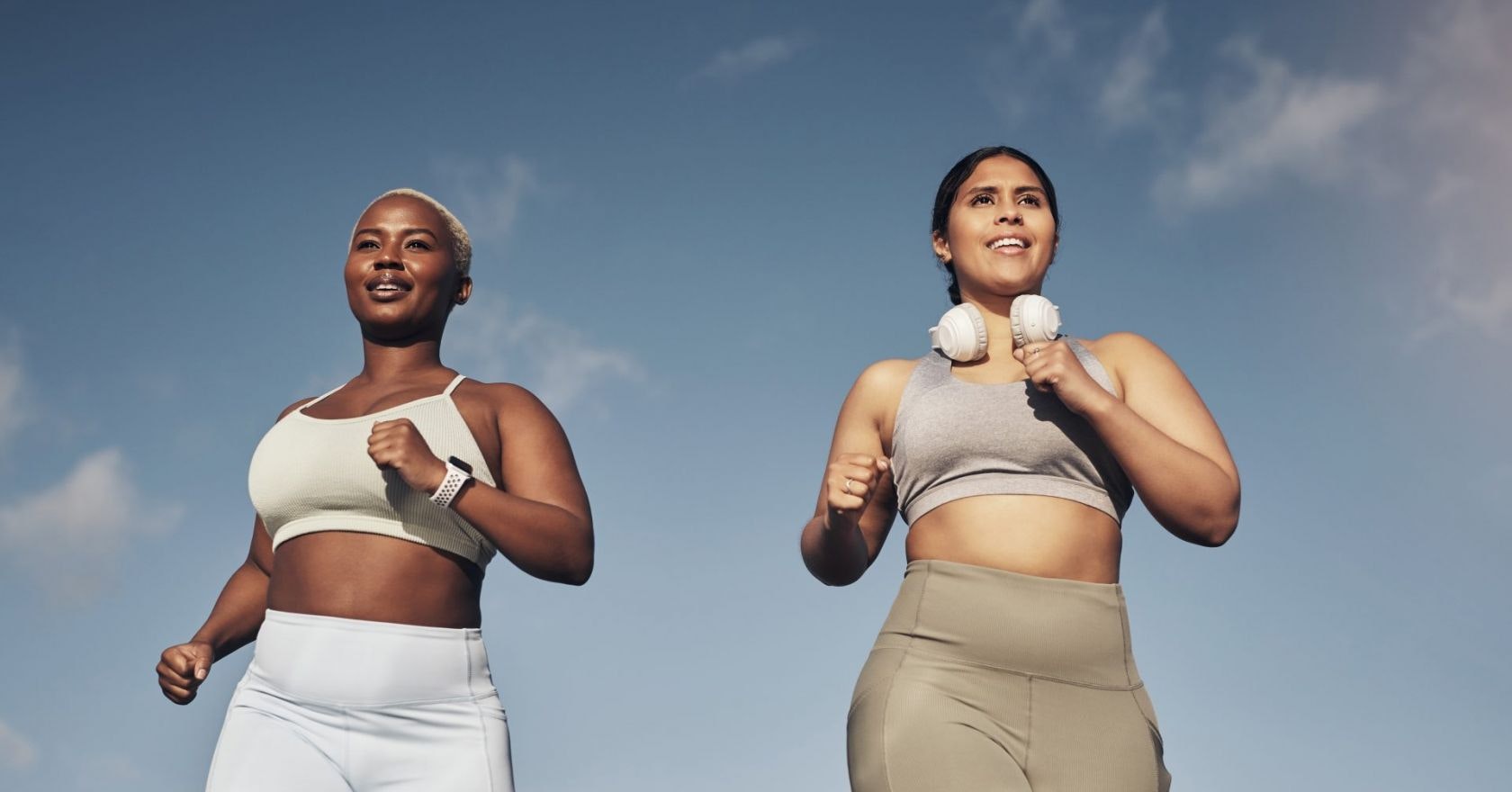
Do you find it hard to lace up and get out when you’re on your period? Writer and runner Katie Yockey explores how to make it a better experience.
Some runs are better than others. Some days you feel like a gazelle; other days your legs feel like they’re made of cement. I run almost every day, so I know not every run is going to be great – but once I started tracking my cycle, I realised my ‘bad weeks’ were always right before my periods.
I get awful cramps, feel nauseous and generally want to curl up in a ball with a heat pack and some biscuits. And after chatting with a few female runner friends, I realised that opinions were really split.
You may also like
Exercising and periods: “I spent a week working out in period pants and here’s why you should too”
Some people, like me, found their PMS woes compounded after a particularly sluggish 10k run. “I don’t actually have cramps until I run,” says Alice*. “I can get about 10 minutes in before it’s excruciating. I usually have to stop running and lie down.”
Some lucky runners don’t have this issue. “Honestly, it doesn’t bother me at all,” says Kelsey*. Others – who I am incredibly jealous of – even run better on their periods.
According to research, there’s no biological reason why our running performance should suffer during menstruation. But this doesn’t mean painful cramps, sore boobs and crippling fatigue can’t affect your runs.
Dr Kerry-Anne Perkins, an OB-GYN, says your hormones are the true culprit of these more difficult runs. “Usually, oestrogen gives you a boost of energy,” she tells Stylist, noting that after ovulation, oestrogen drops, which can sap your energy. At the same time, progesterone – a more calming hormone – rises. “As you get closer and closer to your period, you’ll likely feel less energetic.”
While hormones can affect us around our periods, the amount we’re influenced varies from person to person. If you’re one of the many people who have a tough time running on your period, there are some steps you can take to make your miles way more enjoyable.
How to make your periods run more comfortable
Change your routine
Most of us have a normal loop we run regularly, and if you’re not feeling your best, it can be easy to obsess over how your pace today compares to your pace last week. Switch things up with a different route and try to focus on the new scenery – not your watch.
It can also be helpful to change the type of runs you’re doing. Dr Perkins recommends swapping your usual jog for a HIIT-style run. This could mean doing intervals or hill sprints, which deliver a tough workout in a short amount of time.
Adjust your nutrition
I know, I know. When you’re on your period, all you want is sweets and salty foods. You don’t have to give up the chocolate, but it may be helpful to pay closer attention to what you eat before you head out the door for a run.

“Some women experience nausea or gastrointestinal (GI) upset during their periods, especially if they have IBS or another GI condition,” says Laura Norris, a certified running coach. “I encourage them to stay well hydrated, use ginger chews or ginger tea to manage nausea, and eat a small snack before they run.”
It might also be helpful to add certain foods or drinks to your diet. According to a 2021 review, drinking a carbohydrate-electrolyte beverage before runs was associated with better endurance during the follicular phase (which lasts from the first day of your period until ovulation).
The luteal phase, right before your period starts, is usually when PMS symptoms are at their worst. A 2019 study of female athletes found that supplementing with Montmorency tart cherry juice gave them a higher pain tolerance and better recovery – and while juice alone may not make a significant difference, it could be worth trying if you struggle to get through runs the week before your period. Biona sells it (it’s also available at places like Holland & Barrett).
Distract yourself
If your cramps are the only thing you can think about, do your best to distract yourself. “Music, a podcast or an audiobook can help distract you,” says Norris.
According to a 2020 study published in the Movement Science And Sport Psychology journal, listening to music during endurance exercise can improve performance and reduce perceived exertion (ie how hard a workout feels). So if you’re not feeling your best, find an upbeat playlist before you head out the door. It may make your run feel easier.
Take medication if you need it
There’s nothing wrong with taking medication to manage period pain. “If you have cramps or pain, taking an over-the-counter nonsteroidal anti-inflammatory (NSAID) medication such as ibuprofen, Midol or naproxen prior to running may reduce pelvic and uterine inflammation,” says Dr. Perkins.
But while NSAIDs can manage cramps, they don’t work for everyone. Research shows that they relieve period pain in about one in three women, but they also come with side effects – about two-thirds of women experience nausea, drowsiness and headaches. This means you should find a medication and dosage that works for you because if it agrees with your body, it can make a big difference.
Focus on effort, not time
Comparing your times to your usual pace can be demoralising, and that’s just not productive. Instead of focusing on pace, try shifting your perspective to perceived effort.
Running coach Montana DePasquale notes that right before your period – when PMS symptoms are at their worst – your body will tell you what you are and aren’t up for. When she’s working with her athletes, she adjusts their training plans according to their cycles.
“We might cut a run short or make a hard workout effort-based instead of trying to hit overly precise times,” she says. If a runner has particularly bad PMS, she’ll tailor their training plan accordingly. “I typically make the week before their period a planned ‘down week’ where we scale back on mileage and intensity.”
Norris also has her athletes make changes on the fly when needed. This could mean slightly reducing mileage, lowering the intensity, swapping a run for a yoga or cross-training session, or opting for a full rest day.
You may also like
How to become a better runner: running long versus running fast
Go easy on yourself
Your mental game plays a major role in how you run. Cut yourself some slack if you’re not feeling your best – it’s your hormones, not your willpower.
“If you feel like workouts are harder in the second half of your cycle, you’re not imagining it,” says DePasquale. “Cramps, fatigue, and pain will all make perceived effort higher.”
So acknowledge that you likely won’t feel your best, but try not to dwell on it. And if you’re heading out for a run but just aren’t feeling up to it, don’t force yourself to suffer through.
“Take a rest day,” says Dr Perkins. “You can even plan to walk on menstrual days so you are not disappointed when you are not able to do more.”
Don’t ignore your pain
As women, we tend to pride ourselves on our truly badass pain tolerance. And it’s no joke – research has shown that women actually have a higher pain threshold than men. But that doesn’t mean there’s glory in repeatedly pushing through excruciating pain.
According to Dr Perkins, if you have mild to moderate pain that’s managed with over-the-counter pain relievers, you don’t need to worry. However, “if the pain starts when running, doesn’t get better with medication, or is accompanied by nausea, vomiting, colic or fever, you should see a doctor,” she says. They may be able to diagnose an underlying health condition, like endometriosis, or prescribe stronger medication to manage your pain.
So while there’s no quick-fix for running on your period, truly listening to your body – and knowing yourself – can make a huge difference. “Give yourself grace,” says runner Amy Haas, who is currently on route to running a half marathon in every state of America.
“Do what will make you feel your best that day. If you need extra rest, take it! If you know that getting out for that run and pushing through discomfort will help you feel better… get out there. Sometimes something is better than nothing at all.”
*Names have been changed.
Images: Getty
Don’t feel like heading out for a run today? Have a go at one of our Strength Training for Runners workouts instead.
Source: Read Full Article